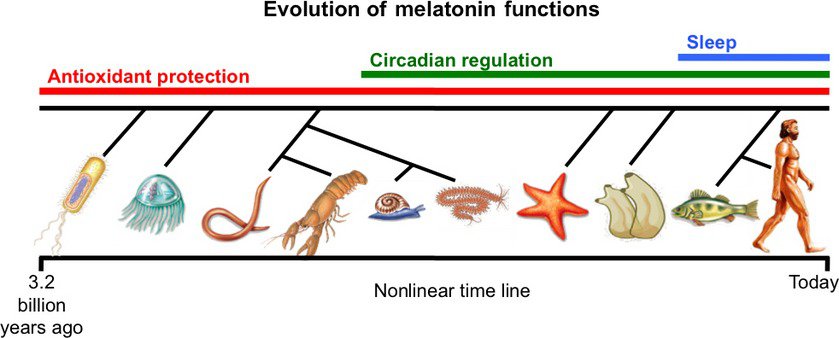Share this post
Beyond sleep, melatonin protects against free radicals
Melatonin’s age-old history in supporting aerobic life
Melatonin is perhaps best known for its effects in regulating circadian rhythms and supporting sleep, but these are newer features of the hormone, evolutionarily-speaking. It’s theorized that melatonin’s original purpose – and primary function to this day – was as an antioxidant.
The first proposed function of melatonin dates back to some 3.5 to 3.2 billion years ago. At that time, cyanobacteria were discovering and developing photosynthesis, the process by which they (along with plants and some bacteria to this day) used sunlight to create food from water and carbon dioxide.[1] Besides food, photosynthesis also generates oxygen and the toxic byproducts of oxygen metabolism – namely free radicals, unstable molecules that can harm cells. It’s thought that the initial function of melatonin in these cyanobacteria was as an antioxidant, protecting them from damage by neutralizing these free radicals.[2],[3]
Melatonin has survived the test of time, and has stayed in the chloroplasts of green plants and in the mitochondria of us aerobic life forms.[4],[5] Indeed, all animals and plants that have been studied seem to contain melatonin.[6]
The high cost of breathing oxygen
Fasting forwarding to today, us two-legged, dynamic humanoids have some things in common with those ancient cyanobacteria. For one, we rely upon oxygen to sustain life. Without oxygen we wouldn’t be able to breathe, and our cells wouldn’t be able to make ATP, or energy. But using oxygen comes at a high metabolic price, as the reactive oxygen species (ROS) – or more specifically, the type of ROS known as free radicals – produced as byproducts of oxygen consumption cause damage in virtually every cell of the body.[7] (These ROS’s are like a metabolic “car exhaust,” invariably produced as a result of burning fuel.) When the amount of free radicals in the body is greater than the amount of antioxidants, our cells, proteins, and even DNA suffer, leaving us at increased risk of chronic health issues and cancer.[8]
We are dependent not only upon oxygen to live, but also upon antioxidants to dampen the “side effects” of [breathing] oxygen.
Oxygen is necessary for sustaining the life of aerobes like us, sure, but it also contributes to disease, and thus we are dependent not only upon oxygen to live, but also upon antioxidants to dampen the “side effects” of that oxygen.[9] It’s no wonder, then, that Mother Nature kept melatonin on the scene to support us in this surprisingly toxic affair of oxygen breathing. Aside from minimizing our exposure to sources of oxidative stress, we can also stave off the harm of free radicals and the oxidative damage they cause by providing the body with naturally-derived antioxidants like green tea extract,[10] pomegranate,[11] chlorophyll-rich foods (such as wheat grass, spirulina, and chlorella),[12] berries, and, of course, melatonin.

How does melatonin work?
Melatonin not only has antioxidant properties of its own, but also stimulates the body’s production of other antioxidants, namely glutathione peroxidase (GPx), superoxide dismutases (SOD), and catalase – both under normal circumstances and under conditions of elevated oxidative stress.[14] Melatonin has also been shown to regulate the expression of several genes pertaining to antioxidant function,[15],[16] in part by upregulating the Nrf2 cell-signaling pathway.[17] Nrf2 regulates various genes related to antioxidant production, detoxification, and cell survival, and has even been called the “master regulator” of the body’s antioxidant response.[18]
Melatonin not only has antioxidant properties of its own, but also stimulates the body’s production of other antioxidants, namely glutathione peroxidase (GPx), superoxide dismutases (SOD), and catalase.
As harmful as ROS’s can be, they can also protect us. For instance, our white blood cells rely on ROS’s to fight off bacterial invasion[19] as well as to attack cancer cells. Quenching all of the free radicals in the body would therefore be detrimental to our health. Context is important, and melatonin has demonstrated its ability to be context-specific. There is no shortage of studies demonstrating melatonin’s antioxidant effects in situations of toxin exposure,[20],[21],[22] inflammation,[23],[24] ischemia-reperfusion injury (as seen after a stroke),[25],[26],[27] as well as in other settings. Yet while it’s technically an antioxidant, melatonin has also demonstrated its functionality as a pro-oxidant – specifically in cancer cells.[28],[29]
Melatonin also has context-specific influences on apoptosis, or cell death. Melatonin has anti-apoptotic actions in normal cells, allowing them to survive. In cancer cells, however, melatonin is often pro-apoptotic, thereby supporting the body’s efforts to return to health.[30],[31],[32]
As one team of researchers put it: “Melatonin is remarkably functionally diverse with actions as a free radical scavenger and antioxidant, circadian rhythm regulator, anti‐inflammatory and immunoregulating molecule, and as an oncostatic agent [substance that prevents the spread of cancer].”[33]
Chemicals, oxygen deprivation, and radiation – oh my!
For obvious reasons, it’s unethical to intentionally expose humans to oxidative stress and its associated health risks. For this reason, much of our understanding of melatonin’s antioxidant benefits is gleaned from animal studies – and the results are compelling. In one such study, melatonin and several of its metabolites were shown to directly repair oxidative damage in DNA caused by chemical exposure.[34]
Melatonin and several of its metabolites were shown to directly repair oxidative damage in DNA caused by chemical exposure.
Similar effects were noted in another study, in which mice were exposed to the toxic chemical warfare agent soman. Whereas the control group developed liver damage, the mice given melatonin in conjunction with soman exposure fared much better. Melatonin demonstrated protective benefits, shielding liver cells from harm by way of its antioxidant effects and by stimulating something called the lysosomal compartment, a reaction by which the body isolates and removes cell-threatening products.[35] In another study, mice with hepatic steatosis (fatty liver) caused by either a high-fat diet or intermittent oxygen deprivation (such as that seen with obstructive sleep apnea) were less likely to have liver damage if they were given melatonin.[36]
Melatonin has also been shown to prevent oxidative-stress-associated mitochondrial dysfunction in the retina (back of the eyeball);[37] preserve brain function, neurological health, memory, and spatial learning after cardiac arrest and CPR resuscitation;[38] and attenuate the changes seen in cardio fibrosis (abnormal thickening of the heart valves).[39] In another study performed on mice with colon cancer, supplementing with melatonin prior to undergoing radiation therapy was shown to protect the lungs and heart muscle, without negating the effects of radiation therapy on the tumor cells.[40]
Melatonin for the muscles and mind
Melatonin’s antioxidant effects have also been shown to protect skeletal muscle (the biceps muscle of rats, specifically) after exposure to carbon tetrachloride (CCl4). Specifically, melatonin supplemented before and/or after CCl4 poisoning was shown to significantly prevent damaging intracellular changes (like creatine-kinase and lactate dehydrogenase leakage), preserve total antioxidant capacity (including glutathione and SOD), and even stave off the muscle fiber disorganization and massive inflammatory cell infiltration typically seen after CCl4 exposure.[41] In short: melatonin was shown to prevent skeletal muscle damage. Although humans thankfully don’t regularly consume CCl4, this animal study may nevertheless offer insight to melatonin’s potential role in preventing the skeletal muscle damage seen in liver disease or as caused by prolonged exercise.
On that note, in a human study examining high intensity interval training (HIIT) athletes, 20 mg of melatonin taken daily for two weeks was shown to improve total antioxidant capacity (TAC) and the glutathione peroxidase (GPx) activity as compared to placebo, with reduced DNA damage noted as well.[42]
Another compelling study demonstrating melatonin’s protective effects on the body (and mind) was performed on humans with fibromyalgia. In this study, melatonin improved mood, anxiety levels, and quality of life while decreasing cortisol (stress hormone) levels in patients with fibromyalgia. Most of these benefits were observed at a dose of 9 mg daily, although the parameters were even better at a dose of 12 mg.[43]
Melatonin improved mood, anxiety levels, and quality of life while decreasing cortisol (stress hormone) levels in patients with fibromyalgia.
The primary site of melatonin production in mammals is in the pineal gland of the brain,[44] and the location of this site couldn’t be better. Melatonin secretion from the pineal gland goes straight into the cerebrospinal fluid (CSF)[45] which bathes the brain and nervous system, thereby allowing melatonin to provide extra protection against free radical damage to these vital areas.
When it comes to protecting the human body against the harms of oxidative stress, it seems melatonin has not only our “backs,” but virtually our entire bodies.
Click here to see References
[1] Photosynthesis [Internet]. Dictionary.com; 2018 [cited 2018 Nov 15]. Available from: https://www.dictionary.com/browse/photosynthesis
[2] Byeon Y, et al. Molecular cloning and functional analysis of serotonin‐N‐acetyltransferase from the cyanobacterium Synechocystis sp. DCC6803. J Pineal Res. 2013; 55:371-6.
[3] Tan DX, et al. The changing biological roles of melatonin during evolution: from an antioxidant to signals of darkness, sexual selection and fitness. Biol Rev Camb Philos Soc. 2010; 85:607-23.
[4] Tan DX, et al. Mitochondria and chloroplasts as the original sites of melatonin synthesis: a hypothesis related to melatonin’s primary function and evolution in eukaryotes. J Pineal Res. 2013; 54:127-38.
[5] Byeon Y, et al. Cellular localization and kinetics of the rice melatonin biosynthetic enzymes SNAT and ASMT. J Pineal Res. 2014; 56:107-14.
[6] Schippers KJ, Nichols SA. Deep, dark secrets of melatonin in animal evolution. Cell 2014; 159:9-10.
[7] Olsen LF, et al. The Yin and Yang of redox regulation. Redox Rep 2013; 18:245-52.
[8] Gupta RK, et al. Oxidative stress and antioxidants in disease and cancer: a review. Asian Pac J Cancer Prev. 2014;15(11):4405-9.
[9] Fridovich I. Oxygen: how do we stand it? Med Princ Pract 2013; 22:131-37.
[10] Na HK, Surh YJ. Modulation of Nrf2-mediated antioxidant and detoxifying enzyme induction by the green tea polyphenol EGCG. Food Chem Toxicol. 2008 Apr;46(4):1271-8.
[11] Husain H, et al. Pomegranate action in curbing the incidence of liver injury triggered by diethylnitrosamine by declining oxidative stress via Nrf2 and NFκB regulation. Sci Rep. 2018 Jun 5;8(1):8606.
[12] Subramoniam A, et al. Chlorophyll revisited: anti-inflammatory activities of chlorophyll a and inhibition of expression of TNF-α gene by the same. Inflammation. 2012 Jun;35(3):959-66.
[13] Manchester LC, et al. Melatonin: an ancient molecule that makes oxygen metabolically tolerable. J. Pineal Res. 2015;59:403-19.
[14] Reiter RJ, et al. Melatonin as an antioxidant: under promises but over delivers. J. Pineal Res. 2016;61:253-78.
[15] Rodriguez C, et al. Regulation of antioxidant enzymes: a significant role for melatonin. J Pineal Res. 2004;36(1):1-9.
[16] Reiter RJ. Oxidative damage in the central nervous system: protection by melatonin. Prog Neurobiol.1998;56(3):359-84.
[17] Tuli HS, et al. Molecular aspects of melatonin (MLT)‐mediated therapeutic effects. Life Sci 2015; 135:147-57.
[18] NFE2L2 nuclear factor, erythroid 2 like 2 [Homo sapiens (human)] Gene ID: 4780 [Internet]. NCBI; 2018 [cited 2018 Jul 24]. Available from: https://www-ncbi-nlm-nih-gov.nunm.idm.oclc.org/gene/4780
[19] Cifani N, et al. Reactive‐oxygen‐species‐mediated P. aeruginosa killing is functional in human cystic fibrosis macrophages. PLoS ONE 2013; 8:e71717.
[20] Reiter RJ, et al. Neurotoxins: free radical mechanisms and melatonin protection. Curr Neuropharmacol 2010; 8:194-210.
[21] Govender J, et al. Mitochondrial catastrophe during doxorubicin‐induced cardiotoxicity: a review of the protective role of melatonin. J Pineal Res 2014; 57:367-80.
[22] Romero A, et al. A review of metal‐catalyzed molecular damage: protection by melatonin. J Pineal Res 2014; 56:343-70.
[23] Calvo JR, et al. The role of melatonin in the cells of the innate immunity: a review. J Pineal Res. 2013; 55:103-9.
[24] Mauriz JL, et al. A review of the molecular aspects of melatonin’s anti‐inflammatory actions: recent insights and new perspectives. J Pineal Res. 2013; 54:1-14.
[25] Sewerynek E, et al. Oxidative damage in the liver induced by ischemia‐reperfusion: protection by melatonin. Hepatogastroenterology. 1996;43:898-905.
[26] Yip HK, et al. Melatonin treatment improves adipose‐derived mesenchymal stem cell therapy for acute lung ischemia‐reperfusion injury. J Pineal Res 2013; 54:207-21.
[27] Liu LF, Qin Q, Shi Met al. Protective effects of melatonin on ischemia‐reperfusion induced myocardial damage and hemodynamic recovery in rats. Eur Rev Med Pharmacol Sci. 2015; 37:318-22.
[28] Zhang HM, Zhang Y. Melatonin: a well‐documented antioxidant with conditional pro‐oxidant actions. J Pineal Res. 2014; 57:131-46.
[29] Gurer‐Orhan H, Suzen S. Melatonin, its metabolites and its synthetic analogs as multi‐faceted compounds: antioxidant, prooxidant and inhibitor of bioactivation reactions. Curr Med Chem 2015; 22:490-9.
[30] Bizzarri M, et al. Molecular mechanisms of the pro‐apoptotic actions of melatonin in cancer cells. Cell Mol Life Sci. 2013; 70:39-57.
[31] Perdomo J, et al. Melatonin induces apoptosis through a caspase‐dependent but reactive oxygen species‐independent mechanism in human leukemia Molt‐3 cells. J Pineal Res. 2013; 55:195-206.
[32] Hong Y, et al. Melatonin treatment induces interplay of apoptosis, autophagy, and senescence in human colorectal cancer cells. J Pineal Res. 2014; 56:264-74.
[33] Manchester LC, et al. Melatonin: an ancient molecule that makes oxygen metabolically tolerable. J. Pineal Res. 2015;59:403-19.
[34] Pérez-González A, et al. Melatonin and its metabolites as chemical agents capable of directly repairing oxidized DNA. J Pineal Res. 2018 Nov 11:e12539.
[35] Król T, et al. Assessment of exogenous melatonin action on mouse liver cells after exposure to soman. Environ Toxicol Pharmacol. 2018 Oct 29;64:147-54.
[36] Ren J, et al. Melatonin prevents chronic intermittent hypoxia-induced injury by inducing sirtuin 1-mediated autophagy in steatotic liver of mice. Sleep Breath. 2018 Nov 8: 1741-4.
[37] Yan G, et al. Melatonin antagonizes oxidative stress-induced mitochondrial dysfunction in retinal pigmented epithelium cells via melatonin receptor 1 (MT1). J Toxicol Sci. 2018;43(11):659-69.
[38] Yang L, et al. Melatonin improves neurological outcomes and preserves hippocampal mitochondrial function in a rat model of cardiac arrest. PLoS One. 2018 Nov 6;13(11):e0207098.
[39] Wu Y, et al. The effect of melatonin on cardio fibrosis in juvenile rats with pressure overload and deregulation of HDACs. Korean J Physiol Pharmacol. 2018 Nov;22(6):607-16.
[40] Abadi S, et al. The effect of melatonin on superoxide dismutase and glutathione peroxidase activity, and malondialdehyde levels in the targeted and the non-targeted lung and heart tissues after irradiation in xenograft mice colon cancer. Curr Mol Pharmacol. 2018;11(4):326-35.
[41] Sokolović DT, et al. Effects of melatonin on oxidative stress parameters and pathohistological changes in rat skeletal muscle tissue following carbon tetrachloride application. Saudi Pharm J. 2018 Nov;26(7):1044-50.
[42] Ortiz-Franco M, et al. Effect of melatonin supplementation on antioxidant status and DNA damage in high intensity trained athletes. Int J Sports Med. 2017 Dec;38(14):1117-25.
[43] Castaño MY, et al. Melatonin improves mood status and quality of life and decreases cortisol levels in fibromyalgia. Biol Res Nurs. 2018 Nov 11:1099800418811634.
[44] Reiter RJ, et al. Delivery of pineal melatonin to the brain and SCN: role of canaliculi, cerebrospinal fluid, tanycytes and Virchow‐Robin perivascular spaces. Brain Struct Funct 2014; 219:1873-87.
[45] Legros C, et al. Melatonin from the cerebrospinal fluid but not from blood reaches sheep cerebral tissues under physiological conditions. J Neuroendocrinol 2014; 26:151-63.
The information provided is for educational purposes only. Consult your physician or healthcare provider if you have specific questions before instituting any changes in your daily lifestyle including changes in diet, exercise, and supplement use.
Share this post
Dr. Erica Zelfand
Related posts
Selenium and Immunity
How this trace mineral supports immune system function Winter is just around the corner – is your immune system up to snuff? (Or sniffles!) The seasonality of infectious diseases is well established,[1],[2] as any of us who have suffered from the flu can attest. All nutrients are required in greater quantity during an infection,…
Improving Erectile Health – Part 2 of 2
Nitric oxide support for sexual health In Part 1 of this series, we looked at the physiology of a type of erectile dysfunction (ED) known as endothelial ED and explained the importance of blood vessel health on male sexual function. This week, we will explore some natural strategies, that have good scientific evidence for…
The Healthspan Imperative
Why healthspan is the new focus of geroscience “Life is short, and the older you get, the more you feel it. Indeed, the shorter it is.” This quote by actor Viggo Mortensen sums up how many people feel when they reach middle age and beyond. They start to realize how important it is to…
Nrf2, Antioxidant Superhero
Fighting oxidative stress and inflammation with natural substances If you cut up an apple and leave it on the counter, you may notice its white flesh turn to brown. A similar effect happens to our own cells when they’re exposed to unstable molecules known as free radicals. This “rusting,” or “browning” process is called…
Are You Getting Enough DHA?
Docosahexaenoic acid for brain and eye health Are you familiar with DHA, also known as docosahexaenoic acid (pronounced doh-koh-sah-hex-ah-een-oh-ick acid)? DHA is the longest-chain omega-3 fatty acid, found in fish oil and in the diet in general. Along with its omega-3 companion, eicosapentaenoic acid (EPA), DHA is essential for health at all ages, which…
Eat Your Antioxidants, My Dear
The healthy person’s guide to fruits and vegetables If you ask the typical American how many servings of vegetables they eat per day, they’ll likely answer, “Not enough.” And they’re right; most of us aren’t getting enough of our plant-based foods or the nutrients they contain. In their 2015-2020 Dietary Guidelines for Americans, theUnited States…
Categories
- Botanicals (56)
- GI Health (53)
- Healthy Aging (121)
- Immune Support (39)
- In The News (39)
- Kids Health (21)
- Stress and Relaxation (50)
- Uncategorized (1)
- Video (9)
- Vitamins & Minerals (51)




